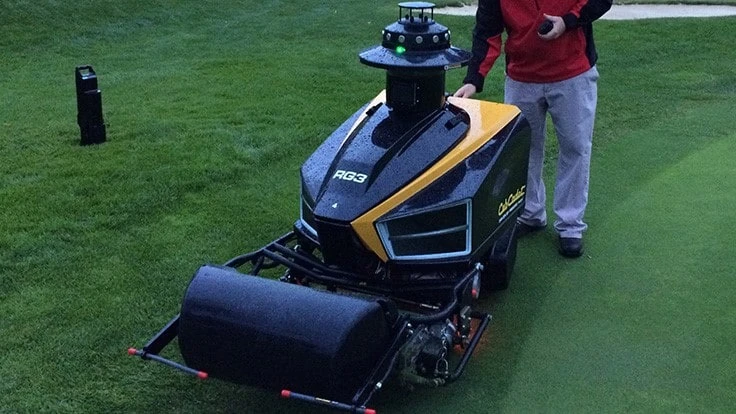
Guy Cipriano
Cub Cadet is out of the autonomous mower market for golf, almost exactly five years after entering the robotic fray and just two weeks after showcasing its technology at the Golf Industry Show.
Cub Cadet informed golf course superintendents Tuesday that it will no longer support its RG3 autonomous turf mowers and rollers, according to three of the superintendents who used them. The company will also shelve its RGX autonomous mower, which was introduced in December and was on display last month at GIS.
The reason, according to Tony Whelan, the director of sales and marketing for Cub Cadet Golf & Sports Turf, were multiple technical challenges that appeared during the last four months of field tests for the RGX that were “just going to take a really long time to address.” Cub Cadet informed customers and potential customers about that delay during GIS conversations before essentially shuttering the project this week.
Whelan says Cub Cadet will “continue to seek solutions” for those challenges, “and we’ll keep the stakeholders involved as we go through it, but it’s going to be a while. With the knowledge of how long we believe it will take to address the technical challenges, we’re simply refocusing our efforts in other areas for the time being.”
Cub Cadet is working with current RG3 users to determine long-term solutions. Some plan to use the tech for the next several months, others are scrambling to find immediate greens mowing solutions.
There is never a good time for news like this, Whelan said, but Cub Cadet and its parent company, MTD Products, needed “to respond to customers who were considering using this for this season. We made the decision now to allow our customers to look for alternative solutions for this grow-in season. We kept dragging it out but that wasn’t helping anybody. This is very painful.”
The reactions among superintendents who have used RG3s for years and who have demoed and tested RGXs was similar. Brian Nettz of Presidio Golf Club in San Francisco, John Shaw of Valley Brook Country Club outside Pittsburgh, and Justin Daigle of Perry Park Country Club outside Denver all expressed disappointment and disbelief to Golf Course Industry.
“It’s really hard to explain to somebody who did utilize the technology all the different options for efficiency,” said Nettz, who turned to a quintet of RG3s to mow greens nine or 10 months out of the year, allowing his crew to hand-rake bunkers that are regularly scattered by Bay Area winds. “It was such a powerful tool for us in how we managed the golf course that it’s just a severe blow. I’m in shock and awe that they would scrap an entire program.”
“I think the mowers are great. One of the best things to happen to the industry,” said Shaw, who was the second golf course superintendent to add RG3s, way back in 2014, even before Cub Cadet sent out its first official news release about the tech. “I’m disappointed they’re not going to be available to me and I really hope somebody else picks up the line and runs with it. It feels like somebody died in my family.”
“I’m bummed because I love autonomy,” said Daigle, who delivered a GIS presentation about the technology last month. “I believe it’s a part of the future, I really, really do. This was a business decision, and it sucks. My biggest disappointment is that I am unlikely to ever have a better green surface than the one produced by the RG3. … It rolled and mowed with no impact. No tire tracks, no footprints. When you were done mowing it, it was perfection. And I just don’t see an autonomous mower coming out without tires. Miracles happen, but it’s unlikely to ever come out again.”
The decision leaves plenty of superintendents with a bevy of questions. Stick with autonomous mowers currently in various levels of development at rivals John Deere and Toro? Turn to triplexes? Revert, for some reason, to walk-behinds? Will a new crew member or two be needed to fill the gap left behind by the autonomous mowers? And how will all this affect budgets?
“Our fiscal year starts October 1,” Nettz said. “It’s going to throw all the trending analysis for this year off. We’re going to have to put an asterisk in the notebooks.” Nettz at least has a small fleet of 15-year-old Toro walk-behind mowers in reserve. He had intended to convert them to tee mowers after acquiring the Cub Cadet RG3s but scrapped that idea because of some logistical problems — “and thank God I did,” he said, “because I’d be screwed right now.”
Praise for the product and the service were universal among the three superintendents. Little more than a day after receiving the news, Shaw says Cub Cadet was “100 percent on the right track with the RGX,” and Nettz called the company’s commitment to shortening the learning curve and teach as “phenomenal,” “unbelievable” and “a partnership.” Daigle described the playing surface produced by the RG3 as “so immaculate.”
“Knowing it’s unlikely to ever be produced again is the only punch to the gut,” he adds.
Officially, the RG3 and the RGX are “indefinitely on hold,” according to Whelan, and that means there is a chance — a sliver, at least — that the tech will return. But odds are good that superintendents will need to grab control of the situation themselves.
Matt LaWell is Golf Course Industry’s managing editor.
Latest from Golf Course Industry
- From the publisher’s pen: Conscientious of a bigger role
- Bernhard and Company partners with Laguna Golf Phuket
- Terre Blanche showcases environmental stewardship
- VIDEO: Introducing our December issue
- Bernhard and Company introduces Soil Scout
- Nu-Pipe donates to GCSAA Foundation’s Centennial Campaign
- GCSAA enhances golf course BMP tool
- Melrose leadership programs sending 18 to 2026 GCSAA Conference and Trade Show





